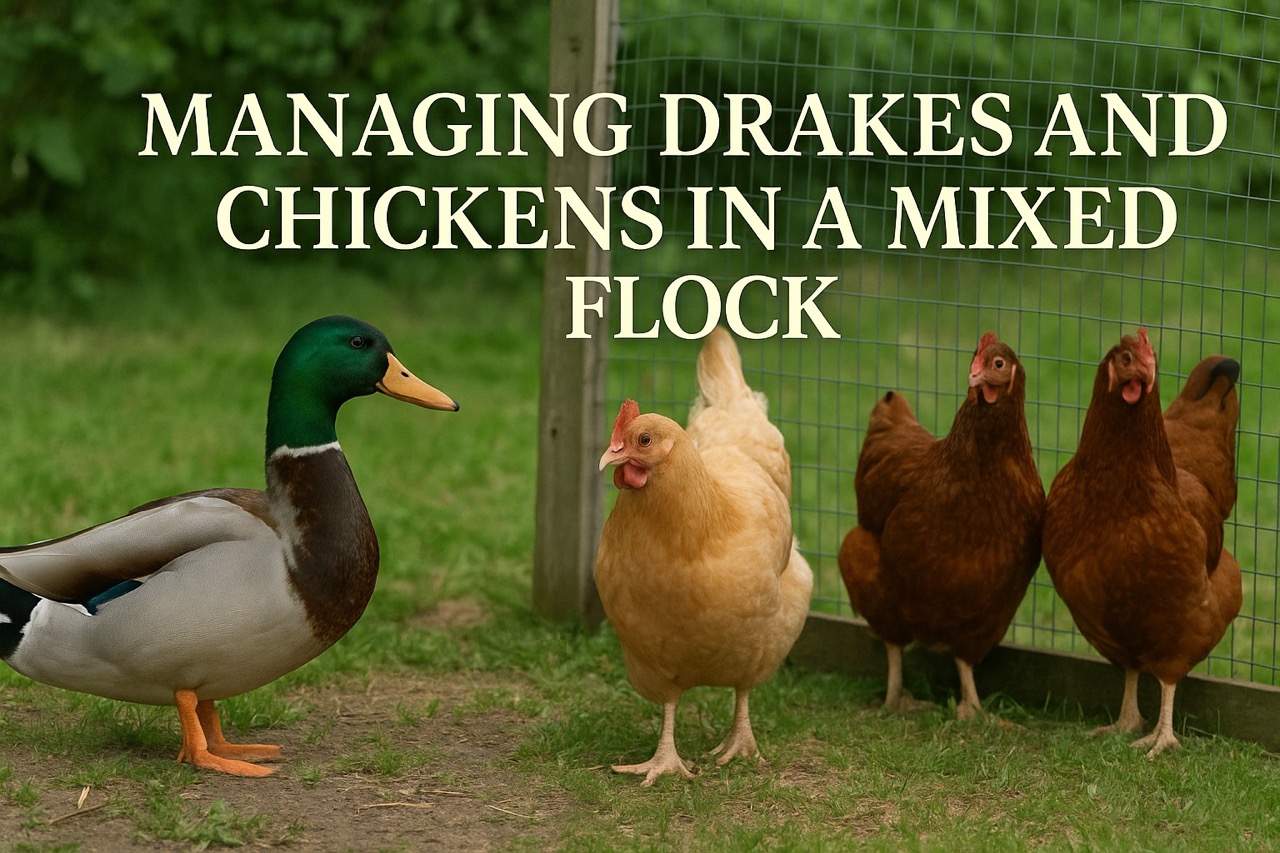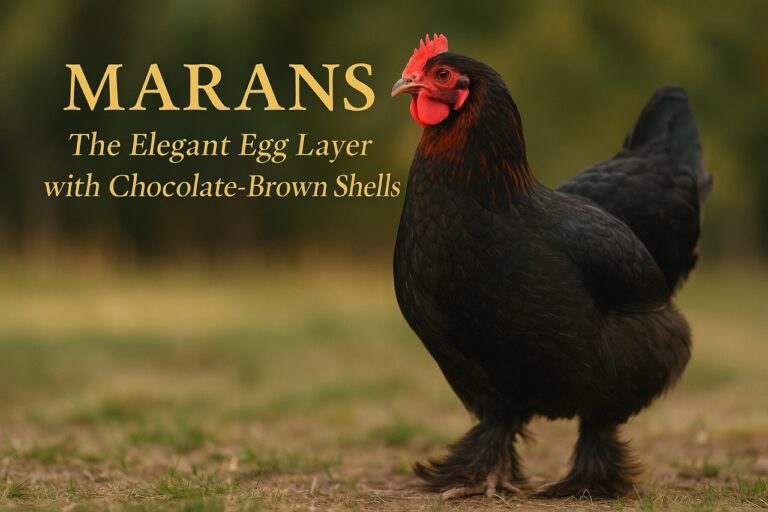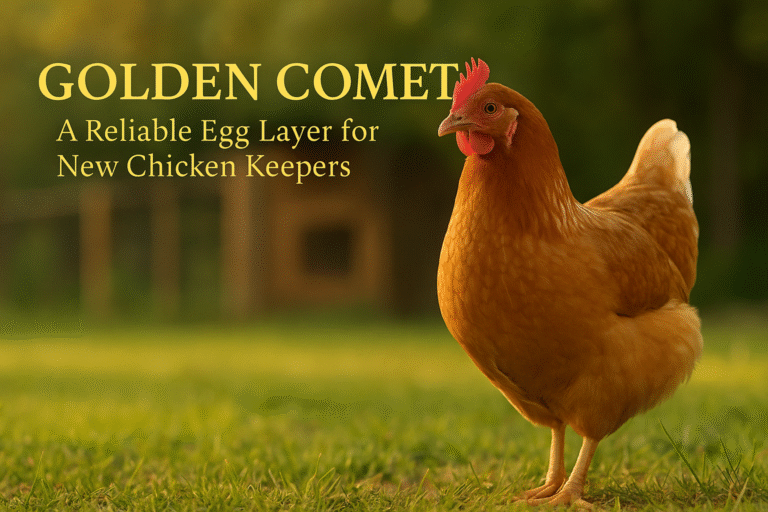Whether you brought home a male duck (drake) intentionally — or discovered him after a few weeks of unexpected behavior — managing drakes and chickens in a mixed flock comes with serious challenges.
Drakes can be territorial, overly aggressive during mating season, and anatomically incompatible with hens, posing real dangers to your flock. But with the right planning, space, and observation, you can keep both your chickens and ducks happy, safe, and productive.
This guide outlines everything you need to know about managing a mixed flock — from anatomical risks to flock ratios, seasonal behavior, and housing solutions.
❗ Why Drakes Can Be Dangerous to Chickens
While it’s common for backyard keepers to house chickens and ducks together, few realize the real risk a drake poses to hens. Here’s why:
1. 🦴 Mating Injuries
Drakes and roosters have very different anatomy. A drake’s phallus can cause:
- Internal trauma
- Broken bones
- Bleeding or egg-laying issues
Even one mating attempt can be life-threatening for a hen.
2. 😠 Aggressive Behavior
During mating season, drakes may:
- Mount hens repeatedly
- Chase and peck other birds
- Guard territory and become dominant
This puts hens and even roosters at risk of stress or injury.
3. 😓 Psychological Stress in Hens
When harassed by a drake, hens may:
- Hide from the flock
- Stop eating or laying
- Show feather loss or limp from injury
🧠 How to Manage Drakes in a Mixed Flock
With planning, you can often maintain peace — especially if you catch early warning signs and adjust accordingly.
✅ 1. Separate During Mating Season
Give chickens and ducks separate housing and runs during spring and summer. Even a movable divider or gated run can help.
Allow supervised mingling only in large, open areas with plenty of escape options for hens.
✅ 2. Maintain the Right Ratio
A drake without enough female ducks will turn his attention to hens.
Ideal ratio: 1 drake to at least 3–4 female ducks
This reduces overmating and misdirected aggression.
✅ 3. Enrich the Environment
Bored, penned-up drakes are more likely to lash out. Prevent that by:
- Adding a kiddie pool or pond
- Letting ducks forage in grass
- Providing logs, climbing areas, and shaded zones
Outdoor run size: 15+ sq ft per bird
More space = less conflict.
✅ 4. Monitor Flock Behavior Daily
Look for signs of:
- Hens hiding, limping, or showing bald spots
- The drake chasing or singling out specific birds
- Changes in egg production or flock cohesion
If signs appear — act fast. Temporarily separate or rehouse the drake before permanent injury occurs.
✅ 5. Remove the Drake if Necessary
If injuries persist, rehome or isolate the drake permanently.
Some keepers opt to house their drake with only ducks or with no hens at all.
⚠️ Signs of Trouble to Watch For
Use this checklist to protect your chickens:
🚩 Injured or Isolated Hens
- Missing feathers
- Cuts or limping
- Avoiding food, shelter, or other birds
🚩 Repeated Mounting or Chasing
- Drakes chasing hens frequently
- Mounting outside of species
- Pecking at chickens aggressively
🛡️ Extra Tips for Safe Mixed Flocks
🧭 1. Adjust Seasonally
Most aggressive drake behavior occurs in spring and early summer.
Plan to:
- Expand space during mating season
- Use temporary fencing to separate species
- Rotate yard access or supervised outings
🐣 2. Provide Separate Shelter
Ducks and chickens have different needs:
- Ducks like open floors and low entrances
- Chickens need nesting boxes and roosting bars
- Avoid overcrowding — both species need space to breathe
🍽️ 3. Feed Separately if Needed
Ducks need more niacin than chickens. Use:
- Duck-specific feed OR
- Chicken layer feed + niacin supplement
Avoid competition by separating feeders or using breed-specific bowls.
🩺 4. Perform Weekly Health Checks
Drake-related injuries can lead to infections if ignored.
Check:
- Hens’ backs, wings, and vents
- Limping or hidden injuries
- Any swelling or behavioral changes
✝️ Sacred Stewardship in Mixed Flock Management
“Know well the condition of your flocks, and give attention to your herds.” — Proverbs 27:23
Stewardship means more than keeping animals alive — it means ensuring their flourishing. Drakes, like all animals, deserve thoughtful care. But when that care jeopardizes the safety of others, we’re called to act with wisdom, compassion, and responsibility.
Sometimes that means separation. Sometimes, rehoming. Either way, the goal is peace, not punishment.
🧩 Final Thoughts: Can Drakes and Chickens Live Together?
Yes — but with caution.
Managing drakes and chickens in a mixed flock requires separation during mating season, careful observation, and the right balance of species. If you provide enough space, enrichment, and attention to flock dynamics, it can work.
But if aggression persists or hens are injured, it’s time to make a change.
Your chickens’ safety comes first.
🔗 Related Reading on Paranoid Prophet
- How Many Chickens to Start With
- Sacred Stewardship: Backyard Chickens
- Backyard Chickens and Ethical Living
- Benefits of Raising Backyard Chickens
- Chicken Dust Bath Guide
SOURCES
- “Drake Mating/Attacking My Hens” – BackYard Chickens
This discussion highlights the dangers of drakes attempting to mate with hens, emphasizing the importance of separating drakes from chickens to prevent serious injuries. Backyard Chickens - “Aggressive Ducks: Why Drakes Attack and How to Permanently Stop Aggression” – Raising Ducks
This article explores the causes of drake aggression, including dominance and mating behaviors, and offers methods to curb such aggression, such as isolation during mating season and ensuring an appropriate male-to-female ratio. Raising Ducks - “5 Ways to Deal With Extra Drakes” – Raising Ducks
This resource discusses managing multiple drakes, recommending a ratio of at least four females per drake to prevent overmating and aggression, and suggests options like creating separate bachelor groups. Raising Ducks - “Why I Will Never Keep a Drake in My Mixed Backyard Flock” – Home in the Finger Lakes
This personal account details the challenges of keeping drakes with chickens, particularly the risks of drakes attempting to mate with hens, which can lead to severe injuries or fatalities. Home in the Finger Lakes - “Aggressive Drakes – Reasons & Solutions” – LearnPoultry
This article examines factors contributing to drake aggression, such as mating season and territoriality, and suggests solutions like providing adequate space and separating aggressive drakes to maintain flock harmony. Learn Poultry
FAQ: Managing Drakes and Chickens in a Mixed Flock
General Questions
1. Why is managing a drake in a mixed flock challenging?
Drakes can exhibit aggressive behavior, particularly during mating season. Their attempts to mate with hens can cause injuries due to anatomical differences, and they may also show territorial aggression toward chickens or other drakes.
2. Can I keep a drake and chickens together?
Yes, but it requires careful management. Providing enough space, maintaining proper male-to-female ratios, and monitoring behavior are crucial for keeping a drake and chickens together safely.
3. How do I know if I accidentally bought a drake?
Drakes are often hard to distinguish from females as ducklings. As they mature, signs like larger size, curled tail feathers (in some breeds), and a raspy quack can indicate you have a drake.
Behavior and Risks
4. What are the risks of a drake mating with a hen?
Drakes can seriously injure hens due to their different reproductive anatomy. Injuries may include broken bones, internal trauma, or even death.
5. Why is my drake attacking my chickens?
Drakes may become territorial or aggressive during mating season. Overcrowding, boredom, or lack of female ducks can also trigger aggressive behavior.
6. How can I tell if my hens are stressed?
Stressed hens may exhibit signs like hiding, avoiding the flock, reduced egg production, or visible injuries such as missing feathers or cuts.
Prevention and Solutions
7. How many female ducks should I have per drake?
To prevent overmating, aim for at least 3-4 female ducks per drake. This ratio helps distribute the drake’s attention and reduces aggression toward chickens.
8. What should I do if my drake is aggressive?
Consider separating the drake during mating season or increasing the flock’s space and enrichment. If aggression persists, housing the drake with ducks only or rehoming him may be necessary.
9. Can I prevent a drake from mating with hens?
Separating chickens and ducks, particularly during mating season, is the most effective way to prevent drakes from attempting to mate with hens. Use partitions or separate runs for added safety.
Care and Maintenance
10. Do drakes and chickens need different feed?
Yes, ducks require more niacin than chickens. Ensure ducks have access to a niacin supplement or feed formulated specifically for ducks.
11. How much space does a mixed flock need?
Provide at least 15 square feet of outdoor space per bird to reduce stress and aggression. Enrichment, such as foraging areas and ponds for ducks, can also help maintain harmony.
12. How can I ensure my flock’s health in a mixed setup?
Perform regular health checks for signs of injury or illness. Clean the coop and run frequently, and provide species-specific shelters, such as roosting bars for chickens and open spaces for ducks.
Seasonal Considerations
13. Is aggression worse during certain seasons?
Yes, mating season (typically in spring) is when aggression and mating behavior are most pronounced. Temporarily separating the flock during this time can reduce conflicts.
14. Should I make seasonal adjustments to housing?
Yes. In winter, ensure ducks have well-ventilated shelter and chickens have dry, warm spaces. In summer, provide shaded areas and water sources to prevent overheating.
What If It’s Too Difficult?
15. What should I do if managing a drake becomes too challenging?
If hens are frequently injured or the drake’s behavior disrupts the flock, consider removing the drake. He can be housed with ducks only or rehomed to ensure the safety of your chickens.




